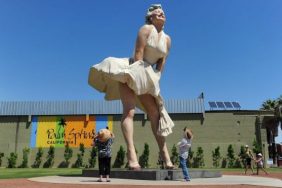Photo: Exhibition view, © Albertina, Vienna
Some photographs are so emblematic that all you need to do is say the word and you can see the image in your mind’s eye. Think of Marilyn Monroe standing atop a subway grate as a gust of air whips her white dress up over her thighs. She smiles with joy as a random man on with approval at his good fortune to be passing by. This image, created to promote Billy Wilder’s 1955 film, The Seven Year Itch, is better than the movie itself—but it did what it set out to do: it put audiences in the seats.
Also: William Kentridge Will Blow Your Mind With “Thick Time”
For the better part of the twentieth century, before the advent of digital technology allowed people to preview movies any time or place, the film still was the critical vehicle to promote and publicize a film to the world at large. The image selected had to be the perfect cocktail of art, advertising, and iconography, eliciting an emotional response that came about through elements of surprise, allure, and mystery. “Who the what now?” would be the best way to describe the initial response—so that the film still could fill in the blanks in a manner that you would never forget.

Sam Shaw, Marilyn Monroe and Tom Ewell in The Seven Year Itch, Director: Billy Wilder, 1954. Gelatin silver print C. Sam Shaw Inc.- licensed by Shaw Family Archives, Private collection
A new exhibition pays homage to the power of the single image to communicate so many things, above all: You must see this film! Film Stills: Photography between Advertising, Art, and the Cinema, currently on view at the Albertina, Vienna, through February 26, 2017, presents 130 images made between 1902 and 1975 in cooperation with the Austrian Film Museum.
The exhibition presents an array of stills from classic films crafted by Deborah Imogen Beer, Horst von Harbou, Pierluigi Praturlon, and Karl Struss, among others, which reveal the overlap between art and commerce. Featuring still from Stanley Kubrick’s 2001: A Space Odyssey, Alfred Hitchcock’s Rear Window, Elia Kazan’s A Streetcar Named Desire, Charles Laughton’s The Night of the Hunter, and Fritz Lang’s Metropolis, the exhibition reveals the many ways in which film stills were used to capture the public’s attention through the distinct features of the photograph.

Anonymous, James Stewart in Rear Window, Director: Alfred Hitchcock, 1954
Gelatin silver print ©BFI National Archive: London
Whereas a film is a series of pictures moving so quickly that your eye does not register them as individual frames, the photograph is but one single frame taken in a fraction of a second. That single frame must not only be composed in a manner that uses the forms of visual language to entice the eye, but it also must be able to communicate the essence of the film while evoking a profound curiosity that will drive audiences to purchase tickets at their earliest convenience.
Consider the still of Jimmy Steward from Rear Window, which shows him in his pajamas with a long-lens camera held in front of his nose. His eyes let us know he is both snooping and concerned about the man he sees in his camera, who is reflected in the lens itself. A middle-aged man smoking a cigarette appears to be on the verge of tearing up a newspaper for a purpose we cannot observe. We look back at Stewart. He seems even more tense. Then we notice the man in the camera does not know he is being watched. There is a glorious feeling of suspense, of action just about to unfold.

Horst von Harbou, Metropolis, Director: Fritz Lang, 1927, Coloured transparent nitrocellulose film, Austrian Theatre Museum © Horst von Harbou – Deutsche Kinemathek
It is a perfectly executed image that makes it clear: there are layers to this story that will answer the questions in our head. The film still makes you want more: you want to be that voyeur right next to Stewart, eating popcorn, on the edge of your seat. The film is a study in voyeurism, which is a fitting metaphor for the film still itself, invoking our desire to watch people who cannot see us back.
Miss Rosen is a New York-based writer, curator, and brand strategist. There is nothing she adores so much as photography and books. A small part of her wishes she had a proper library, like in the game of Clue. Then she could blaze and write soliloquies to her in and out of print loves.







